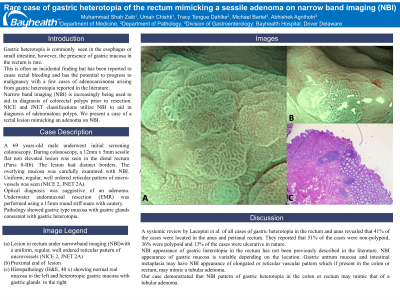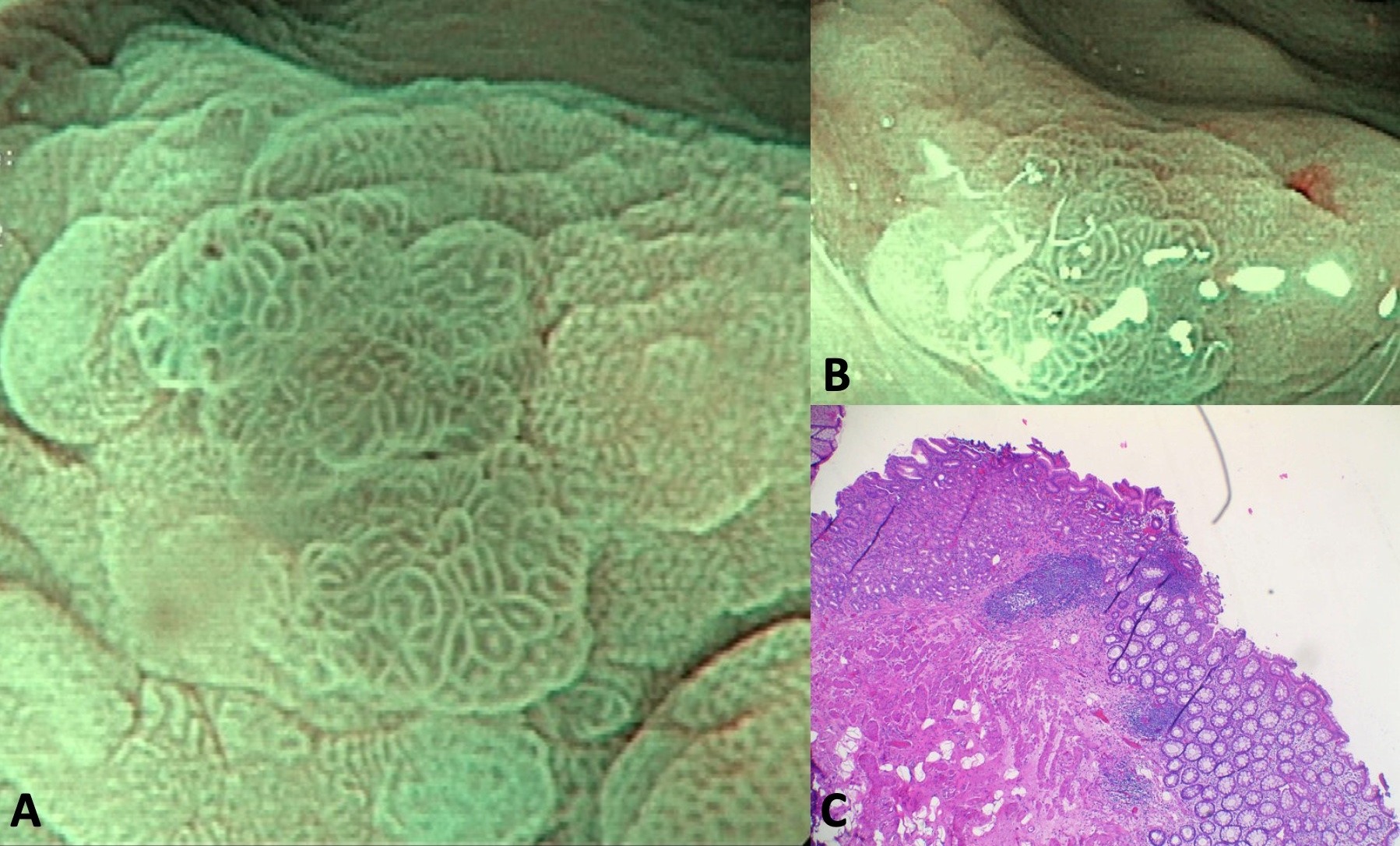Tuesday Poster Session
Category: Colon
P3074 - Rare Case of Gastric Heterotopia of the Rectum Mimicking a Sessile Adenoma on Narrow Band Imaging
Tuesday, October 24, 2023
10:30 AM - 4:00 PM PT
Location: Exhibit Hall

Has Audio

Muhammad Shah Zaib, MD
Bayhealth Medical Center
Dover, DE
Presenting Author(s)
Muhammad Shah Zaib, MD1, Umair Chishti, MD2, Tracy Dahlke, MD1, Michael Bartel, MD1, Abhishek Agnihotri, MD2
1Bayhealth Medical Center, Dover, DE; 2Bayhealth Hospital, Dover, DE
Introduction: Gastric heterotopia is not uncommonly seen in the esophagus or small intestine, however, the presence of gastric mucosa in the rectum is rare. Males are affected more frequently. This is often an incidental finding but has been reported to cause rectal bleeding and has the potential to progress to malignancy with a few cases of adenocarcinoma arising from gastric heterotopia reported in the literature. Narrow band imaging (NBI) is increasingly being used to aid in diagnosis of colorectal polyps prior to resection. NICE and JNET classifications utilize NBI to aid in diagnosis of adenomatous polyps. Paris classification is utilized to describe the morphologic pattern of polyps. We present an interesting case of a rectal lesion mimicking an adenoma on NBI.
Case Description/Methods: A 69 years-old male underwent initial screening colonoscopy. During colonoscopy, a subtle 12mm x 5mm sessile flat non elevated lesion was seen in the distal rectum (Paris 0-IIb). The lesion had distinct borders. The overlying mucosa was carefully examined with NBI. Uniform, regular, well ordered reticular pattern of micro-vessels was seen (NICE 2, JNET 2A). Optical diagnosis was suggestive of an adenoma. Underwater endomucosal resection (EMR) was performed using a 15mm round stiff snare with cautery. Polyp lifted adequately under water and was resected in an en-bloc fashion. No residual polyp remained. No evidence of bleeding or perforation seen. Two endoclips were applied for mucosal defect closure. Pathology showed gastric type mucosa with gastric glands consistent with gastric heterotopia.
Discussion: A systemic review by Lacopini et al. of all cases of gastric heterotopia in the rectum and anus revealed that 41% of the cases were located in the anus and perianal rectum. They reported that 51% of the cases were non-polypoid, 36% were polypoid and 13% of the cases were ulcerative in nature. NBI appearance of gastric heterotopia in the rectum has not been previously described in the literature. NBI appearance of gastric mucosa is variable depending on the location. Gastric antrum mucosa and intestinal metaplasia may have NBI appearance of elongated or reticular vascular pattern which if present in the colon or rectum, may mimic an adenoma. Our case demonstrated that NBI pattern of gastric heterotopia in the colon or rectum may mimic that of an adenoma.

Disclosures:
Muhammad Shah Zaib, MD1, Umair Chishti, MD2, Tracy Dahlke, MD1, Michael Bartel, MD1, Abhishek Agnihotri, MD2. P3074 - Rare Case of Gastric Heterotopia of the Rectum Mimicking a Sessile Adenoma on Narrow Band Imaging, ACG 2023 Annual Scientific Meeting Abstracts. Vancouver, BC, Canada: American College of Gastroenterology.
1Bayhealth Medical Center, Dover, DE; 2Bayhealth Hospital, Dover, DE
Introduction: Gastric heterotopia is not uncommonly seen in the esophagus or small intestine, however, the presence of gastric mucosa in the rectum is rare. Males are affected more frequently. This is often an incidental finding but has been reported to cause rectal bleeding and has the potential to progress to malignancy with a few cases of adenocarcinoma arising from gastric heterotopia reported in the literature. Narrow band imaging (NBI) is increasingly being used to aid in diagnosis of colorectal polyps prior to resection. NICE and JNET classifications utilize NBI to aid in diagnosis of adenomatous polyps. Paris classification is utilized to describe the morphologic pattern of polyps. We present an interesting case of a rectal lesion mimicking an adenoma on NBI.
Case Description/Methods: A 69 years-old male underwent initial screening colonoscopy. During colonoscopy, a subtle 12mm x 5mm sessile flat non elevated lesion was seen in the distal rectum (Paris 0-IIb). The lesion had distinct borders. The overlying mucosa was carefully examined with NBI. Uniform, regular, well ordered reticular pattern of micro-vessels was seen (NICE 2, JNET 2A). Optical diagnosis was suggestive of an adenoma. Underwater endomucosal resection (EMR) was performed using a 15mm round stiff snare with cautery. Polyp lifted adequately under water and was resected in an en-bloc fashion. No residual polyp remained. No evidence of bleeding or perforation seen. Two endoclips were applied for mucosal defect closure. Pathology showed gastric type mucosa with gastric glands consistent with gastric heterotopia.
Discussion: A systemic review by Lacopini et al. of all cases of gastric heterotopia in the rectum and anus revealed that 41% of the cases were located in the anus and perianal rectum. They reported that 51% of the cases were non-polypoid, 36% were polypoid and 13% of the cases were ulcerative in nature. NBI appearance of gastric heterotopia in the rectum has not been previously described in the literature. NBI appearance of gastric mucosa is variable depending on the location. Gastric antrum mucosa and intestinal metaplasia may have NBI appearance of elongated or reticular vascular pattern which if present in the colon or rectum, may mimic an adenoma. Our case demonstrated that NBI pattern of gastric heterotopia in the colon or rectum may mimic that of an adenoma.

Figure: Image Legend
(a) Lesion in rectum under narrow band imaging (NBI) with uniform, regular, well ordered reticular pattern of micro-vessels (NICE 2, JNET 2A)
(b) Proximal end of lesion
(c) Histopathology (H&E, 40x) showing normal rectal mucosa to the left and heterotopic gastric mucosa with gastric glands to the right.
(a) Lesion in rectum under narrow band imaging (NBI) with uniform, regular, well ordered reticular pattern of micro-vessels (NICE 2, JNET 2A)
(b) Proximal end of lesion
(c) Histopathology (H&E, 40x) showing normal rectal mucosa to the left and heterotopic gastric mucosa with gastric glands to the right.
Disclosures:
Muhammad Shah Zaib indicated no relevant financial relationships.
Umair Chishti indicated no relevant financial relationships.
Tracy Dahlke indicated no relevant financial relationships.
Michael Bartel indicated no relevant financial relationships.
Abhishek Agnihotri indicated no relevant financial relationships.
Muhammad Shah Zaib, MD1, Umair Chishti, MD2, Tracy Dahlke, MD1, Michael Bartel, MD1, Abhishek Agnihotri, MD2. P3074 - Rare Case of Gastric Heterotopia of the Rectum Mimicking a Sessile Adenoma on Narrow Band Imaging, ACG 2023 Annual Scientific Meeting Abstracts. Vancouver, BC, Canada: American College of Gastroenterology.

